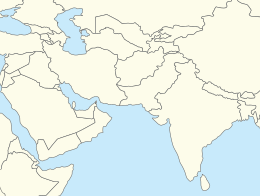|
Persian gardens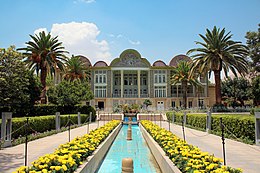 The tradition and style of garden design represented by Persian gardens or Iranian gardens (Persian: باغ ایرانی) is a style of "landscape" garden which emerged in the Achaemenid Empire. Humayun's Tomb and the Taj Mahal have some of the largest Persian gardens in the world, from the era of the Mughal Empire in India. Concept and etymology From the time of the Achaemenid Empire, the idea of an earthly paradise spread through Persian literature and example to other cultures, both the Hellenistic gardens of the Seleucid Empire and the Ptolemies in Alexandria. The Avestan word pairidaēza-, Old Persian *paridaida-,[note 1] or Median *paridaiza- "walled-around", (i.e., a walled garden), were borrowed into Elamite (partetaš) and Akkadian, and later as Ancient Greek: παράδεισος, romanized: parádeisos. It was rendered as Latin paradīsus, and from there entered into European languages, e.g., French paradis, German Paradies, and English paradise.[1] In the Achaemenid Empire, the term is used for functional worksites as well, and it translated as "plantations"; these sites contained not only orchards and tree plantations, but also sometimes bitumen harvesting and mining. The same word was used to describe the Elamite custom of creating a sacred grove or husa surrounding a royal grave that was the site of worship of the deceased king.[2] As the word expresses, such gardens would have been enclosed. Gardens provided a place for protected relaxation, both spiritual and leisurely, and represented a paradise on earth. The Common Iranian word for "enclosed space" was *pari-daiza- (Avestan pairi-daēza-). This term was adopted to describe the garden of Eden a Paradise on earth.[3] The garden's construction may be formal (with an emphasis on structure) or casual (with a focus on nature), following several simple design rules. This allows the maximum possible use of the garden in terms of function and emotion. History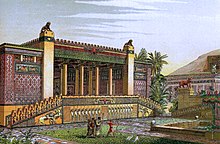 Persian gardens may originate as early as 4000 BC, but it is clear that this tradition began with the Achaemenid dynasty around the 6th century BCE.[4][dubious – discuss][verification needed] Decorated pottery of that time displays the typical cross plan of the Persian garden. The outline of Pasargadae, built around 500 BC, is still viewable today. Classical Iranians were seen by the Greeks as the 'great gardeners' of antiquity; Cyrus II (known also as Cyrus the Younger) is alleged to have told the Spartan commander Lysander that he gardened daily when not campaigning, and had himself laid out the park at Sardis, which he called his 'paradise' (a Greek corruption of the Old Persian word for garden). [5] During the suzerainty of the Sasanian Empire, under the influence of Zoroastrianism, water in art grew increasingly important. This trend manifested itself in garden design, with greater emphasis on fountains and ponds in gardens. During the Umayyad and Abbasid periods, the aesthetic aspect of the garden increased in importance, overtaking utility. During this time, aesthetic rules that govern the garden grew in importance. An example of this is the chahār bāgh (چهارباغ), a form of garden that attempts to emulate the Abrahamic notion of a Garden of Eden, with four rivers and four quadrants that represent the world. The design sometimes extends one axis longer than the cross-axis and may feature water channels that run through each of the four gardens and connect to a central pool.
The invasion of Persia by the Mongols in the thirteenth century led to a new emphasis on highly ornate structure in the garden. Examples of this include tree peonies and chrysanthemums.[clarification needed] The Mongols then carried a Persian garden tradition to other parts of their empire (notably India).  The Mughal emperor Babur introduced the Persian garden to India, attempting to replicate the cool, refreshing aura of his homeland in the Ferghana Valley through the construction of Persian-style gardens, like those at other Timurid cities like Samarkand and Herat. Babur was a zealous gardener and personally designed and supervised at least ten gardens in his capital of Kabul in modern Afghanistan, such as the Bagh-e Babur, where he recorded the allure of the pomegranate, cherry and orange trees he had planted.[7] Though his empire soon expanded as far as north-central India, he abhorred the stagnant heat and drab environment of the hot, dusty plains of India; he was thus interred at Bagh-e Babur in Kabul by his widow in 1544.[6] The Aram Bagh of Agra was the first of many Persian gardens he created in India itself. Mughal gardens have four basic requirements, symbolizing four allegorical essentials for the afterlife: shade, fruit, fragrance, and running water. This pattern was used to build many Persian gardens throughout the Indian subcontinent, such as the Shalimar Gardens of Lahore, the Shalimar Bagh and Nishat Bagh of Kashmir, and the Taj Mahal gardens. The Taj Mahal gardens embody the Persian concept of an ideal paradise garden, and were built with irrigation channels and canals from the Yamuna River. These gardens have recently been restored to their former beauty after decades of pollution by the Indian authorities, who cut down the fruit- and shade-bearing vegetation of the garden.[8][9][10]  The Safavid dynasty (seventeenth to eighteenth century) built and developed grand and epic layouts that went beyond a simple extension to a palace and became an integral aesthetic and functional part of it. In the following centuries, European garden design began to influence Persia, particularly the designs of France, and secondarily that of Russia and the United Kingdom. Western influences led to changes in the use of water and the species used in bedding. Traditional forms and style are still applied in modern Iranian gardens. They also appear in historic sites, museums, and affixed to the houses of the rich. Elements of the Persian garden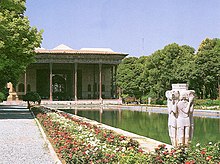 Sunlight and its effects were an important factor of structural design in Persian gardens. Textures and shapes were specifically chosen by architects to harness the light.[11] Iran's dry heat makes shade important in gardens, which would be nearly unusable without it. Trees and trellises largely feature as biotic shade; pavilions and walls are also structurally prominent in blocking the sun. The heat also makes water important, both in the design and maintenance of the garden. Irrigation may be required, and may be provided via a form of tunnel called a qanat, that transports water from a local aquifer. Well-like structures then connect to the qanat, enabling the drawing of water. Alternatively, an animal-driven Persian well would draw water to the surface. Such wheel systems also moved water around surface water systems, such as those in the chahar bāgh style. Trees were often planted in a ditch called a juy, which prevented water evaporation and allowed the water quick access to the tree roots. The Persian style often attempts to integrate indoors with outdoors through the connection of a surrounding garden with an inner courtyard. Designers often place architectural elements such as vaulted arches between the outer and interior areas to open up the divide between them. Descriptions An early description (from the first half of the fourth century BCE) of a Persian garden is found in Xenophon's Oeconomicus in which he has Socrates relate the story of the Spartan general Lysander's visit to the Persian prince Cyrus the Younger, who shows the Greek his "paradise at Sardis". In this story Lysander is "astonished at the beauty of the trees within, all planted at equal intervals, the long straight rows of waving branches, the perfect regularity, the rectangular symmetry of the whole, and the many sweet scents which hung about them as they paced the park"[12] 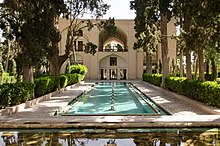 The oldest representational descriptions and illustrations of Persian gardens come from travelers who reached Iran from the west. These accounts include Ibn Battuta in the fourteenth century, Ruy González de Clavijo in the fifteenth century and Engelbert Kaempfer in the seventeenth century. Battuta and Clavijo made only passing references to gardens and did not describe their design, but Kaempfer made careful drawings and converted them into detailed engravings after his return to Europe. They show charbagh-type gardens that featured an enclosing wall, rectangular pools, an internal network of canals, garden pavilions and lush planting. There are surviving examples of this garden type at Yazd (Dowlatabad) and at Kashan (Fin Garden). The location of the gardens Kaempfer illustrated in Isfahan can be identified. StylesThe six primary styles of the Persian garden may be seen in the following table, which puts them in the context of their function and style. Gardens are not limited to a particular style, but often integrate different styles, or have areas with different functions and styles.
Hayāt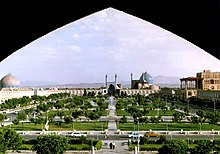   Publicly, it is a classical Persian layout with heavy emphasis on aesthetics over function. Man-made structures in the garden are particularly important, with arches and pools (which may be used to bathe). The ground is often covered in gravel flagged with stone. Plantings are typically very simple - such as a line of trees, which also provide shade. Privately, these gardens are often pool-centred and, again, structural. The pool serves as a focus and source of humidity for the surrounding atmosphere. There are few plants, often due to the limited water available in urban areas. MeidānThis is a public, formal garden that puts more emphasis on the biotic element than the hayāt and that minimises structure. Plants range from trees, to shrubs, to bedding plants, to grasses. Again, there are elements such as a pool and gravel pathways which divide the lawn. When structures are used, they are often built, as in the case of pavilions, to provide shade. Chahar BāghThese gardens are private and formal. The basic structure consists of four quadrants divided by waterways or pathways. Traditionally, the rich used such gardens in work-related functions (such as entertaining ambassadors). These gardens balance structure with greenery, with the plants often around the periphery of a pool and path based structure. BoostānMuch like many other parks, the Persian park serves a casual public function with emphasis on plant life. They provide pathways and seating, but are otherwise usually limited in terms of structural elements. The purpose of such places is relaxation and socialisation. BāghLike the other casual garden, the park, bāgh emphasizes the natural and green aspect of the garden. Unlike the park it is a private area often affixed to houses and often consisting of lawns, trees, and ground plants. The waterways and pathways stand out less than in the more formal counterparts and are largely functional. The primary function of such areas is familial relaxation. World Heritage Sites
See alsoNotes
References
Further reading
External linksWikimedia Commons has media related to Gardens in Iran.
|
||||||||||||||||||||||||||||
